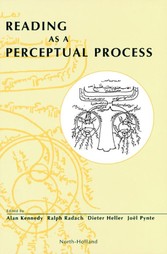Suchen und Finden
Service
Reading as a Perceptual Process
A. Kennedy, D. Heller, J. Pynte
Verlag Elsevier Trade Monographs, 2000
ISBN 9780080515762 , 771 Seiten
Format PDF, ePUB, OL
Kopierschutz DRM
Geräte
Front Cover
1
Reading as a Perceptual Process
4
Copyright Page
5
Contents
10
Historical Perspective
3
Reading as a Perceptual Process?
6
List of Contributors
14
Section 1: Visual Word Processing
20
Chapter 1. Traces of Print Along the Visual Pathway
22
Chapter 2. When Words with Higher-frequency Neighbours Become Words with No Higher-frequency Neighbour (Or How to Undress the Neighbourhood Frequency Effect)
42
Chapter 3. Words Likely to Activate Many Lexical Candidates Are Granted an Advantage: Evidence from Within-word Eye Movements
66
Chapter 4. Processing of Finnish Compound Words in Reading
84
Chapter 5. Perceiving Spatial Attributes of Print
108
Chapter 6. Saccadic Inhibition and Gaze Contingent Research Paradigms
138
Commentary on Section 1. From Print to Meaning via Words?
166
Section 2: Attention, Information Processing and Eye Movement Control
182
Chapter 7. Relations Between Spatial and Temporal Aspects of Eye Movement Control
184
Chapter 8. Attention Allocation in Reading: Sequential or Parallel?
212
Chapter 9. Allocation of Visuo-Spatial Attention and Saccade Programming During Reading
240
Chapter 10. Attentional Demands on the Processing of Neighbouring Words
266
Chapter 11. Eye Guidance and the Saliency of Word Beginnings in Reading Text
288
Chapter 12. Regressive Saccades and Word Perception in Adult Reading
320
Chapter 13. Planning Two-Saccade Sequences in Reading
346
Commentary on Section 2. Attention, Information Processing and Eye Movement Control
374
Section 3: Phonology in Reading
394
Chapter 14. The Assembly of Phonology in Italian and English: Consonants and Vowels
396
Chapter 15. Phonological Coding in Word Perception and Reading
418
Chapter 16. Phonology is Used to Access Word Meaning during Silent Reading: Evidence from Lexical Ambiguity Resolution
446
Chapter 17. Do Readers Use Phonological Codes to Activate Word Meanings? Evidence from Eye Movements
466
Commentary on Section 3. Dual Routes from Print to Speech and Dual Routes from Print to Meaning: Some Theoretical Issues
494
Section 4: Syntax and Discourse Processing
510
Chapter 18. Modifier Attachment in Dutch: Testing Aspects of Construal Theory
512
Chapter 19. Modifier Attachment in German: Relative Clauses and Prepositional Phrases
536
Chapter 20. Decoupling Syntactic Parsing from Visual Inspection: The Case of Relative Clause Attachment in French
548
Chapter 21. 'Romancing' Syntactic Ambiguity: Why the French and the Italians don't See Eye to Eye
568
Chapter 22. Commas and Spaces: Effects of Punctuation on Eye Movements and Sentence Parsing
584
Chapter 23. Effects of the Focus Particle Only and Intrinsic Contrast on Comprehension of Reduced Relative Clauses
610
Chapter 24. Unrestricted Race: A New Model of Syntactic Ambiguity Resolution
640
Commentary on Section 4. Sentence Processing: Issues and Measures
668
Section 5: Models and Simulations
684
Chapter 25. Saccade Planning in Reading with Central Scotomas: Comparison of Human and Ideal Performance
686
Chapter 26. Eye Fixation Durations in Reading: Models of Frequency Distributions
702
Chapter 27. Eye Movement Control in Reading: Updating the E-Z Reader Model to Account for Initial Fixation Locations and Refixations
720
Commentary on Section 5. Five Questions about Cognitive Models and Some Answers from Three Models of Reading
740
Author Index
752
Subject Index
764
Service
Shop



